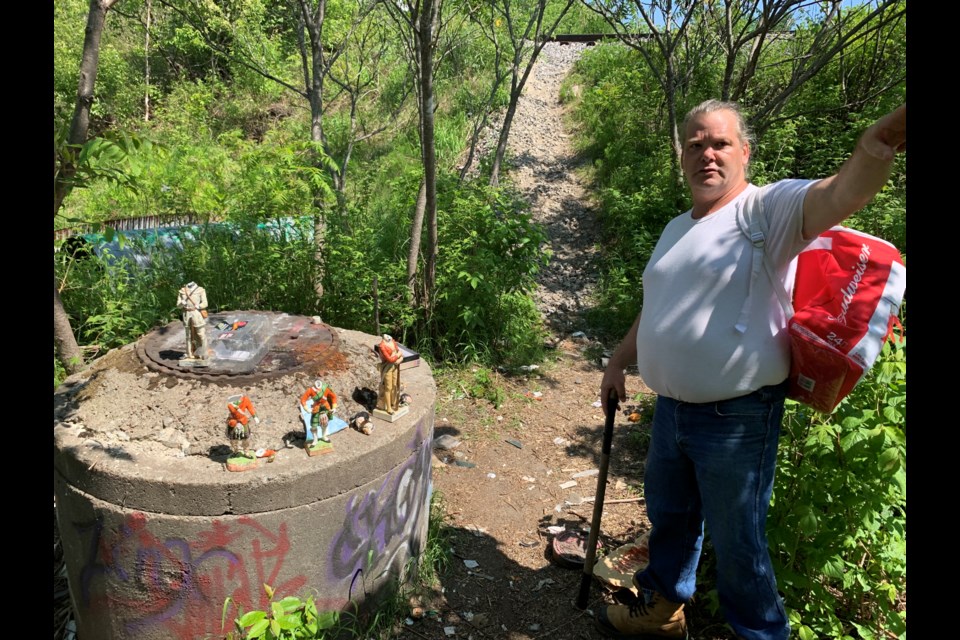It takes less than two-minute walk into the bush behind Northgate Shopping Centre to find the strange world of the homeless.
Along a narrow, path at the edge of the parking lot on the east side of the building, Shane Moyer takes me for a short walk into this territory.
Within about 10 metres, we run into a homeless indigenous man on the narrow path. He's wearing jeans, a windbreaker, a ball cap, and a surgical mask while leaning on a shopping cart.
Moyer believes he wears the mask more to conceal his identity than to keep him safe from COVID-19.
As we walk by him, we follow the narrow path next to a small creek, that ends just below the train tracks running above. It's here where we find a storm drain with assorted china military statues with the heads removed, set up in some ceremonial-like circle. On the ground, you can see the remnants of a small fire and food wrappers and other garbage surrounding the small area.
"This little area behind the mall is a little area where they set up, they do their needles and at the end of the day they will sit here and wait for Walmart to put out their day-old stuff into the bins and they will take the food out of the bins," said Moyer.
"That is what a lot of them will live on, aside from eating at the soup kitchen and stuff that is given to them."
Shane Moyer has been working with a small group of concerned citizens trying to clean up abandoned homeless areas like this with the priority of picking up disposed needles.
"We go around picking up the needles and from there hopefully we will help the police patrol the streets at night and hopefully stop some of the thefts that are going on at night."
Moyer now lives in an apartment on Cassells Street.
He says he collects a monthly Ontario Disability cheque and does some trade work to keep busy and pay the bills.
However, he knows what homeless life is all about and the shame that comes with it.
"I spent eight years being homeless," said Moyer, who admits he had an addiction problem.
"I got tired of running in and out of jails and institutions. Being homeless, it is just a very difficult life to live. It really is because you are in the elements 24/7 and there is really no place you can call home.
"It is hard, it is rough. You get looked down upon whether you are a vagrant or not, but because you are homeless you are looked down upon."
Moyer says it's very hard when you are homeless to convince a landlord that you will be a reliable tenant.
"Landlords won't rent to you because you are homeless, because you are dirty, or you smell, or you are just unkempt or whatever," he said.
"So that's it, this is where you live and, sorry to say, but a lot of them with addictions and drug use comes with the thefts, comes with the stealing, comes with the vagrancy with a lot of people because they use what little money they get in order to survive. Not just to support their habit but also to eat, to maybe get in from the cold for a night in a nice hotel room, to get a shower, or cleaned up."
Moyer admits he has met and knows many of the homeless crowd in the North Bay area. He believes the new homeless shelter at Pete Palangio Arena has been helpful to the homeless population. He says many still prefer to live in the bush, while some will go back and forth.
See related: Stickhandling through the challenges of operating a rink turned homeless shelter
See related: What it is like being homeless during a pandemic
But Pete Palangio will not operate as a homeless shelter forever, as the COVID-19 emergency shelter funding is expected to run out at the end of June.
The former OPP building on Chippewa Street will become a new homeless shelter location, but Moyer believes the homeless need more care or even a bigger facility such as the now vacant Widdifield Secondary School location on Ski Club Road.
See: Old OPP building to become homeless shelter
"They need more of a group home setting," said Moyer.
"Some of them cannot fend for themselves. They don't have the basic skills to even cook or even know how to look after themselves. So they need more of a group home setting and not a crisis shelter where they have staff that comes in and does the cooking, they do the cleaning and just kind of help them out, give them a guiding hand where they can have a spot for injection booths or where they can use and they are monitored. They need respite beds for the transients that come in and out that are just passing through from city to city."
Moyer has found some addiction hot spots in the city, sometimes finding as many as 40 to 50 needles at one location.
"We find a lot in the downtown parking areas in the parking garage and down around the bus station where they can go find spots behind the hills and stuff like that," he said.
"We make sure those areas are clean for the kids so people don't get hurt."
Moyer believes a group home would help alleviate the area's homeless problem.
"If you have that you won't see spots like this where there's garbage in the bushes, and the garbage and the needles in your park areas,' he said.



